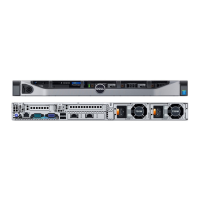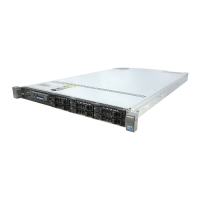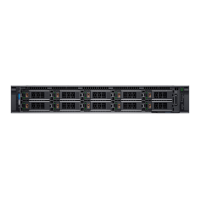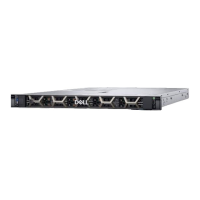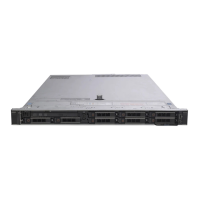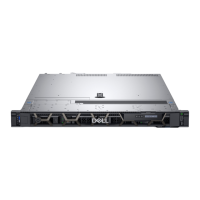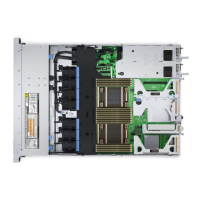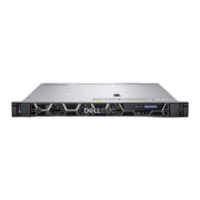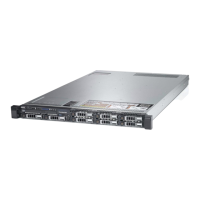




Do you have a question about the Dell PowerEdge R620 and is the answer not in the manual?
| Storage drive size | 2.5 \ |
|---|---|
| Hot-swap drive bays | Yes |
| Storage drive capacity | - GB |
| Storage drive interface | Serial ATA |
| Total installed storage capacity | - TB |
| Maximum supported storage capacity | 10 TB |
| Number of storage drives installed | - |
| Number of storage drives supported | 10 |
| Maximum RAM supported | 768 GB |
| Tcase | 70 °C |
| Bus type | QPI |
| Stepping | M1 |
| Scalability | 2S |
| Processor cache | 10 MB |
| Processor cores | 4 |
| Processor model | E5-2609 |
| System bus rate | 6.4 GT/s |
| Processor socket | LGA 2011 (Socket R) |
| Motherboard chipset | Intel C600 |
| Processor frequency | 2.4 GHz |
| Processor cache type | Smart Cache |
| Processor lithography | 32 nm |
| Processor manufacturer | Intel |
| Processor package size | 52.5 x 45.0 mm |
| Processor front side bus | - MHz |
| PCI Express slots version | 3.0 |
| Processor operating modes | 64-bit |
| Thermal Design Power (TDP) | 80 W |
| Compatible processor series | Intel® Xeon® |
| Number of processors installed | 2 |
| CPU multiplier (bus/core ratio) | 24 |
| Memory bandwidth supported by processor (max) | 34.1 GB/s |
| Maximum internal memory supported by processor | 750 GB |
| Chassis type | Rack (1U) |
| Product color | Silver |
| Processor ARK ID | 64588 |
| Compatible operating systems | Windows Server 2008 R2 SP1, x64 (Hyper-V v2), Windows HPC Server 2008, Windows Small Business Server 2011, SUSE Linux Enterprise Server, Red Hat Enterprise Linux, Optional Embedded Hypervisors: Citrix XenServer/VMware vSphere |
| Sustainability certificates | ENERGY STAR |
| Embedded options available | No |
| Maximum number of PCI Express lanes | 40 |
| Memory types supported by processor | DDR3-SDRAM |
| Memory channels supported by processor | Quad |
| Intel Identity Protection Technology version | 0.00 |
Details the various indicators, buttons, and connectors on the front panel of the system.
Explains the functionality and navigation of the system's LCD panel.
Describes the Home screen display and navigation for system status.
Outlines the options available within the system setup menu for configuration.
Details the options for viewing system information such as IP, MAC, and temperature.
Explains the system's diagnostic indicators and their meanings.
Describes the indicator patterns for hard drive activity and status.
Details the various indicators, buttons, and connectors on the back panel of the system.
Lists and explains the indicator codes for Network Interface Cards (NICs).
Explains the indicator codes for AC and DC power supplies.
Provides general information and warnings related to system use.
Explains how to select the boot mode (BIOS or UEFI) for operating system installation.
Provides instructions on how to access the system setup utility.
Guides on how to handle system error messages during boot.
Details the keyboard keys used for navigating the system setup interface.
Lists general capabilities and options available within System Setup.
Describes the main System BIOS configuration screen and its options.
Explains how to view system details like model, BIOS version, and service tag.
Details how to view and configure memory-related settings.
Outlines settings related to processor configuration and performance.
Describes how to enable or disable SATA controllers and ports.
Covers options for setting the system's boot mode and sequence.
Explains how to enable or disable integrated hardware devices.
Details configuration for serial ports and console redirection.
Covers settings for system profiles, CPU, and memory performance.
Outlines options for system passwords, TPM, and BIOS security.
Covers settings for system time, date, asset tag, and keyboard options.
Explains system and setup password features and their creation.
Step-by-step guide to setting system and setup passwords.
Instructions for modifying or removing system/setup passwords.
How to use the system password to secure the system.
Explains the behavior when a setup password is enabled.
Instructions to enter the UEFI Boot Manager for boot options.
Details navigation keys within the Boot Manager.
Lists and describes options within the Boot Manager screen.
Explains options for managing UEFI boot entries.
Overview of the Dell Lifecycle Controller for system management.
Introduction to the iDRAC Settings utility for iDRAC configuration.
Steps to access the iDRAC Settings utility.
How to customize thermal control settings via iDRAC.
Lists tools required for installing system components.
Instructions for removing and installing the front bezel.
Step-by-step guide for opening and closing the system chassis.
Overview of internal system components and layout.
Procedure for removing and installing the cooling shroud.
Details system memory support, types, and frequencies.
Provides recommendations for optimal memory configuration and installation.
Explains memory configuration guidelines for different modes (ECC, Mirroring, Sparing).
Tables showing sample memory configurations for single and dual processors.
Step-by-step guide for safely removing memory modules.
Step-by-step guide for safely installing memory modules.
Overview of hard drive connections and carriers.
Procedure for removing a 2.5-inch hard-drive blank.
Procedure for installing a 2.5-inch hard-drive blank.
Steps to safely remove a hot-swap hard drive.
Steps to safely install a hot-swap hard drive.
How to remove a hard drive from its carrier.
How to install a hard drive into its carrier.
Information about the optional optical drive.
Procedure for removing the optical drive.
Procedure for installing the optical drive.
Overview of the system's hot-swappable cooling fans.
Procedure for removing a cooling fan.
Procedure for installing a cooling fan.
Details on the optional internal USB memory key.
Procedure for replacing the internal USB memory key.
Introduction to expansion cards and risers.
Guidelines for installing PCI Express expansion cards.
Steps to safely remove an expansion card.
Steps to safely install an expansion card.
Procedure for removing expansion-card risers.
Procedure for installing expansion-card risers.
Information about the vFlash SD card and its function.
Procedure for replacing the SD vFlash card.
Details about the internal dual SD module.
Procedure for removing the internal dual SD module.
Procedure for installing the internal dual SD module.
Information about the internal SD card.
Procedure for removing an internal SD card.
Procedure for installing an internal SD card.
Overview of the integrated storage controller card.
Procedure for removing the integrated storage controller.
Procedure for installing the integrated storage controller.
Information about the network daughter card.
Procedure for removing the network daughter card.
Procedure for installing the network daughter card.
Introduction to processor installation and replacement.
Steps to safely remove a processor.
Steps to safely install a processor.
Overview of supported AC and DC power supply modules.
Explanation of the Hot Spare feature for power supply redundancy.
Procedure for removing an AC power supply.
Procedure for installing an AC power supply.
Guidelines for wiring DC power supplies.
Steps for assembling and connecting the safety ground wire.
Instructions for assembling DC input power wires.
Procedure for removing a DC power supply.
Procedure for installing a DC power supply.
Procedure for removing a power supply blank.
Procedure for installing a power supply blank.
Overview of the system battery.
Step-by-step guide for replacing the system battery.
Details configurations supported by hard-drive backplanes.
Procedure for removing the hard-drive backplane.
Procedure for installing the hard-drive backplane.
Introduction to the control panel assembly.
Procedure to remove the control panel board for an 8-drive system.
Procedure to install the control panel board for an 8-drive system.
Procedure to remove the control panel from an 8-drive system.
Procedure to install the control panel for an 8-drive system.
Procedure to remove the control panel for a 10-drive system.
Procedure to install the control panel for a 10-drive system.
Information on the VGA module.
Procedure for removing the VGA module.
Procedure for installing the VGA module.
Overview of the system board.
Steps to safely remove the system board.
Steps to safely install the system board.
General safety precautions for system troubleshooting.
Steps to diagnose and resolve system startup issues.
Checks for external cable connections before troubleshooting devices.
Steps to diagnose issues with the video display.
Guide to troubleshooting USB keyboard/mouse and other USB devices.
Steps to diagnose and resolve issues with serial devices.
Guide to troubleshooting Network Interface Card (NIC) connectivity.
Procedure for handling systems exposed to liquid.
Steps to check component installation after system damage.
Steps to diagnose and resolve system battery issues.
Guide to diagnosing and resolving power supply problems.
Steps to diagnose and resolve general cooling issues.
Guide to troubleshooting cooling fan problems.
Steps to diagnose and resolve system memory issues.
Guide to troubleshooting the internal USB key.
Steps to diagnose and resolve issues with SD cards.
Guide to troubleshooting optical drive problems.
Steps to diagnose and resolve tape backup unit issues.
Guide to diagnosing and resolving hard drive problems.
Steps to diagnose and resolve storage controller issues.
Guide to diagnosing and resolving expansion card problems.
Steps to diagnose and resolve processor issues.
Details on running stand-alone diagnostic programs for system components.
Information on Enhanced Pre-boot System Assessment (ePSA) diagnostics.
Guidance on when to use embedded system diagnostics for component failure.
Procedure for initiating the embedded system diagnostics program.
Describes controls for managing and viewing system diagnostic results.
Details the settings for system board jumpers, including PWRD_EN and NVRAM_CLR.
Identifies and describes system board connectors for various components.
Details processor type, family, and supported models.
Information on the system's expansion bus type and slots.
Specifications for memory architecture, module types, capacities, and speeds.
Details supported hard drive configurations and optical drive options.
Information on the optional SATA DVD-ROM drive.
Lists and describes back and front panel connectors.
Specifications for video type and memory.
Details system operation within expanded temperature ranges.
Lists restrictions and conditions for operating in expanded temperatures.
Information on environmental limits to prevent equipment damage.
Describes brief text messages displayed on the LCD for system events.
Instructions on how to view errors or status messages on the LCD.
Methods to clear messages from the LCD display.
Lists and explains system error messages for problem notification.
Provides information on how to contact Dell for support and service.
